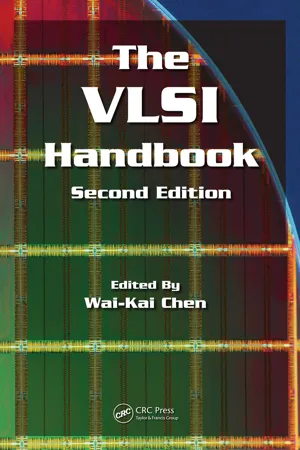
- 2,320 pages
- English
- PDF
- Available on iOS & Android
The VLSI Handbook
About This Book
For the new millenium, Wai-Kai Chen introduced a monumental reference for the design, analysis, and prediction of VLSI circuits: The VLSI Handbook. Still a valuable tool for dealing with the most dynamic field in engineering, this second edition includes 13 sections comprising nearly 100 chapters focused on the key concepts, models, and equations.Written by a stellar international panel of expert contributors, this handbook is a reliable, comprehensive resource for real answers to practical problems. It emphasizes fundamental theory underlying professional applications and also reflects key areas of industrial and research focus. WHAT'S IN THE SECOND EDITION?
Sections on…
- Low-power electronics and design
- VLSI signal processing
Chapters on…
- CMOS fabrication
- Content-addressable memory
- Compound semiconductor RF circuits
- High-speed circuit design principles
- SiGe HBT technology
- Bipolar junction transistor amplifiers
- Performance modeling and analysis using SystemC
- Design languages, expanded from two chapters to twelve
- Testing of digital systems
Structured for convenient navigation and loaded with practical solutions, The VLSI Handbook, Second Edition remains the first choice for answers to the problems and challenges faced daily in engineering practice.
Frequently asked questions
Information
Table of contents
- Front cover
- Preface
- Editor-in-Chief
- Contributors
- Table of Contents
- Section I. VLSI Technology
- Chapter 1. Bipolar Technology
- Chapter 2. CMOS/BiCMOS Technology
- Chapter 3. Silicon-on-Insulator Technology
- Chapter 4. SiGe HBT Technology
- Chapter 5. Silicon Carbide Technology
- Chapter 6. Passive Components
- Chapter 7. Power IC Technologies
- Chapter 8. Microelectronics Packaging
- Chapter 9. Multichip Module Technologies
- Section II. Devices and their Models
- Chapter 10. Bipolar Junction Transistor Circuits
- Chapter 11. RF Passive IC Components
- Chapter 12. CMOS Fabrication
- Chapter 13. Analog Circuit Simulation
- Chapter 14. Interconnect Modeling and Simulation
- Section III. Low Power Electronics and Design
- Chapter 15. System-Level Power Management: An Overview
- Chapter 16. Communication-Based Design for Nanoscale SoCs
- Chapter 17. Power-Aware Architectural Synthesis
- Chapter 18. Dynamic Voltage Scaling for Low-Power Hard Real-Time Systems
- Chapter 19. Low Power Microarchitecture Techniques
- Chapter 20. Architecture and Design Flow Optimizations for Power-Aware FPGAs
- Chapter 21. Technology Scaling and Low-Power Circuit Design
- Section IV. Amplifiers
- Chapter 22. CMOS Amplifier Design
- Chapter 23. Bipolar Junction Transistor Amplifiers
- Chapter 24. High-Frequency Amplifiers
- Chapter 25. Operational Transconductance Amplifiers
- Section V. Logic Circuits
- Chapter 26. Expressions of Logic Functions
- Chapter 27. Basic Theory of Logic Functions
- Chapter 28. Simplification of Logic Expressions
- Chapter 29. Binary Decision Diagrams
- Chapter 30. Logic Synthesis with AND and OR Gates in Two Levels
- Chapter 31. Sequential Networks
- Chapter 32. Logic Synthesis with AND and OR Gates in Multi-Level
- Chapter 33. Logic Properties of Transistor Curcuits
- Chapter 34. Logic Synthesis with NAND (or NOR) Gates in Multi-Levels
- Chapter 35. Logic Synthesis with a Minimum Number of Negative Gates
- Chapter 36. Logic Synthesizer with Optimizations in Two Phases
- Chapter 37. Logic Synthesizer by the Transduction Method
- Chapter 38. Emitter-Coupled Logic
- Chapter 39. CMOS
- Chapter 40. Pass Transistors
- Chapter 41. Adders
- Chapter 42. Multipliers
- Chapter 43. Dividers
- Chapter 44. Full-Custom and Semi-Custom Design
- Chapter 45. Programmable Logic Devices
- Chapter 46. Gate Arrays
- Chapter 47. Field-Programmable Gate Arrays
- Chapter 48. Cell-Library Design Approach
- Chapter 49. Comparison of Different Design Approaches
- Section VI. Memory, Registers and Sysem Timing
- Chapter 50. System Timing
- Chapter 51. ROM/PROM/EPROM
- Chapter 52. SRAM
- Chapter 53. Embedded Memory
- Chapter 54. Flash Memories
- Chapter 55. Dynamic Random Access Memory
- Chapter 56. Content-Addressable Memory
- Chapter 57. Low-Power Memory Circuits
- Section VII. Analog Circuits
- Chapter 58. Nyquist-Rate ADC and DAC
- Chapter 59. Oversampled Analog-to-Digital and Digital-to-Analog Converters
- Chapter 60. RF Communication Circuits
- Chapter 61. PLL Circuits
- Chapter 62. Switched-Capacitor Filters
- Section VIII. Microprocessor and ASIC
- Chapter 63. Timing and Signal Integrity Analysis
- Chapter 64. Microprocessor Design Verification
- Chapter 65. Microprocessor Layout Method
- Chapter 66. Architecture
- Chapter 67. Logic Synthesis for Field Programmable Gate Array (FPGA) Technology
- Section IX. Testing of Digital Systems
- Chapter 68. CAD DFT and Test Architectures
- Chapter 69. Automatic Test Pattern Generation
- Chapter 70. Built-In Self-Test
- Section X. Compound Semiconductor Integrated Circuit Technology
- Chapter 71. Compound Semiconductor Materials
- Chapter 72. Compound Semiconductor Devices for Analog and Digital Circuits
- Chapter 73. Compound Semiconductor RF Circuits
- Chapter 74. High-Speed Circuit Design Principles
- Section XI. Design Automation
- Chapter 75. Internet-Based Micro-Electronic Design Automation (IMEDA) Framework
- Chapter 76. System-Level Design
- Chapter 77. Performance Modeling and Analysis Using VHDL and SystemC
- Chapter 78. Embedded Computing Systems and Hardware/Software Co-Design
- Chapter 79. Design Automation Technology Roadmap
- Section XII. VLSI Signal Processing
- Chapter 80. Computer Arithmetic for VLSI Signal Processing
- Chapter 81. VLSI Architectures for JPEG 2000 EBCOT: Design Techniques and Challenges
- Chapter 82. VLSI Architectures for Foreward Error-Control Decoders
- Chapter 83. An Exploration of Hardware Architectures for Face Detection
- Chapter 84. Multidimensional Logarithmic Number System
- Section XIII. Design Languages
- Chapter 85. Languages for Design and Implementation of Hardware
- Chapter 86. System Level Design Languages
- Chapter 87. RT Level Hardware Description with VHDL
- Chapter 88. Register Transfer Level Hardware Description with Verilog
- Chapter 89. Register-Transfer Level Hardware Description with SystemC
- Chapter 90. System Verilog
- Chapter 91. VHDL-AMS Hardware Description Language
- Chapter 92. Verification Languages
- Chapter 93. ASIC and Custom IC Cell Information Representation
- Chapter 94. Test Languages
- Chapter 95. Timing Description Languages
- Chapter 96. HDL-Based Tools and Environments
- Index
- Back cover